ICG-001 Exerts Potent Anticancer Activity Against Uveal Melanoma Cells
- PMID: 29332125
- PMCID: PMC5769500
- DOI: 10.1167/iovs.17-22454
ICG-001 Exerts Potent Anticancer Activity Against Uveal Melanoma Cells
Abstract
Purpose: Uveal melanoma (UM) is uniformly refractory to all available systemic chemotherapies, thus creating an urgent need for novel therapeutics. In this study, we investigated the sensitivity of UM cells to ICG-001, a small molecule reported to suppress the Wnt/β-catenin-mediated transcriptional program.
Methods: We used a panel of UM cell lines to examine the effects of ICG-001 on cellular proliferation, migration, and gene expression. In vivo efficacy of ICG-001 was evaluated in a UM xenograft model.
Results: ICG-001 exerted strong antiproliferative activity against UM cells, leading to cell cycle arrest, apoptosis, and inhibition of migration. Global gene expression profiling revealed strong suppression of genes associated with cell cycle proliferation, DNA replication, and G1/S transition. Gene set enrichment analysis revealed that ICG-001 suppressed Wnt, mTOR, and MAPK signaling. Strikingly, ICG-001 suppressed the expression of genes associated with UM aggressiveness, including CDH1, CITED1, EMP1, EMP3, SDCBP, and SPARC. Notably, the transcriptomic footprint of ICG-001, when applied to a UM patient dataset, was associated with better clinical outcome. Lastly, ICG-001 exerted anticancer activity against a UM tumor xenograft in mice.
Conclusions: Using in vitro and in vivo experiments, we demonstrate that ICG-001 has strong anticancer activity against UM cells and suppresses transcriptional programs critical for the cancer cell. Our results suggest that ICG-001 holds promise and should be examined further as a novel therapeutic agent for UM.
Figures
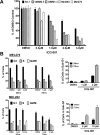
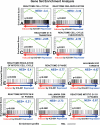
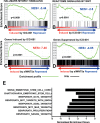


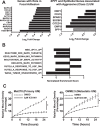
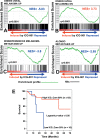
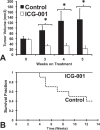
Similar articles
-
The CREB-binding protein inhibitor ICG-001 suppresses pancreatic cancer growth.Mol Cancer Ther. 2014 Oct;13(10):2303-14. doi: 10.1158/1535-7163.MCT-13-1005. Epub 2014 Jul 31. Mol Cancer Ther. 2014. PMID: 25082960 Free PMC article.
-
In vitro and in vivo anti-uveal melanoma activity of JSL-1, a novel HDAC inhibitor.Cancer Lett. 2017 Aug 1;400:47-60. doi: 10.1016/j.canlet.2017.04.028. Epub 2017 Apr 26. Cancer Lett. 2017. PMID: 28455241
-
Natural withanolide withaferin A induces apoptosis in uveal melanoma cells by suppression of Akt and c-MET activation.Tumour Biol. 2012 Aug;33(4):1179-89. doi: 10.1007/s13277-012-0363-x. Epub 2012 Apr 5. Tumour Biol. 2012. PMID: 22477711
-
Uveal melanoma modeling in mice and zebrafish.Biochim Biophys Acta Rev Cancer. 2024 Jan;1879(1):189055. doi: 10.1016/j.bbcan.2023.189055. Epub 2023 Dec 15. Biochim Biophys Acta Rev Cancer. 2024. PMID: 38104908 Review.
-
The application of natural compounds in uveal melanoma drug discovery.J Pharm Pharmacol. 2022 May 20;74(5):660-680. doi: 10.1093/jpp/rgac009. J Pharm Pharmacol. 2022. PMID: 35532546 Review.
Cited by
-
The Pivotal Roles of the Epithelial Membrane Protein Family in Cancer Invasiveness and Metastasis.Cancers (Basel). 2019 Oct 23;11(11):1620. doi: 10.3390/cancers11111620. Cancers (Basel). 2019. PMID: 31652725 Free PMC article. Review.
-
A novel inflammatory response-related signature predicts the prognosis of cutaneous melanoma and the effect of antitumor drugs.World J Surg Oncol. 2022 Aug 19;20(1):263. doi: 10.1186/s12957-022-02726-8. World J Surg Oncol. 2022. PMID: 35982458 Free PMC article.
-
Recent advances in understanding the role of HES6 in cancers.Theranostics. 2022 May 20;12(9):4374-4385. doi: 10.7150/thno.72966. eCollection 2022. Theranostics. 2022. PMID: 35673577 Free PMC article. Review.
-
EMP1 correlated with cancer progression and immune characteristics in pan-cancer and ovarian cancer.Mol Genet Genomics. 2024 May 14;299(1):51. doi: 10.1007/s00438-024-02146-1. Mol Genet Genomics. 2024. PMID: 38743077
-
Dysfunction of dendritic cells in tumor microenvironment and immunotherapy.Cancer Commun (Lond). 2024 Sep;44(9):1047-1070. doi: 10.1002/cac2.12596. Epub 2024 Jul 25. Cancer Commun (Lond). 2024. PMID: 39051512 Free PMC article. Review.
References
-
- Bedikian AY. . Metastatic uveal melanoma therapy: current options. Int Ophthalmol Clin. 2006; 46: 151– 166. - PubMed
-
- Collaborative Ocular Melanoma Study Group The COMS randomized trial of iodine 125 brachytherapy for choroidal melanoma: V. Twelve-year mortality rates and prognostic factors: COMS report No. 28. Arch Ophthalmol. 2006; 124: 1684– 1693. - PubMed
-
- Marshall E, Romaniuk C, Ghaneh P,et al. . MRI in the detection of hepatic metastases from high-risk uveal melanoma: a prospective study in 188 patients. Br J Ophthalmol. 2013; 97: 159– 163. - PubMed
-
- Spagnolo F, Caltabiano G, Queirolo P. . Uveal melanoma. Cancer Treat Rev. 2012; 38: 549– 553. - PubMed
-
- Kujala E, Makitie T, Kivela T. . Very long-term prognosis of patients with malignant uveal melanoma. Invest Ophthalmol Vis Sci. 2003; 44: 4651– 4659. - PubMed
Publication types
MeSH terms
Substances
Grants and funding
LinkOut - more resources
Full Text Sources
Other Literature Sources
Medical
Molecular Biology Databases
Miscellaneous

